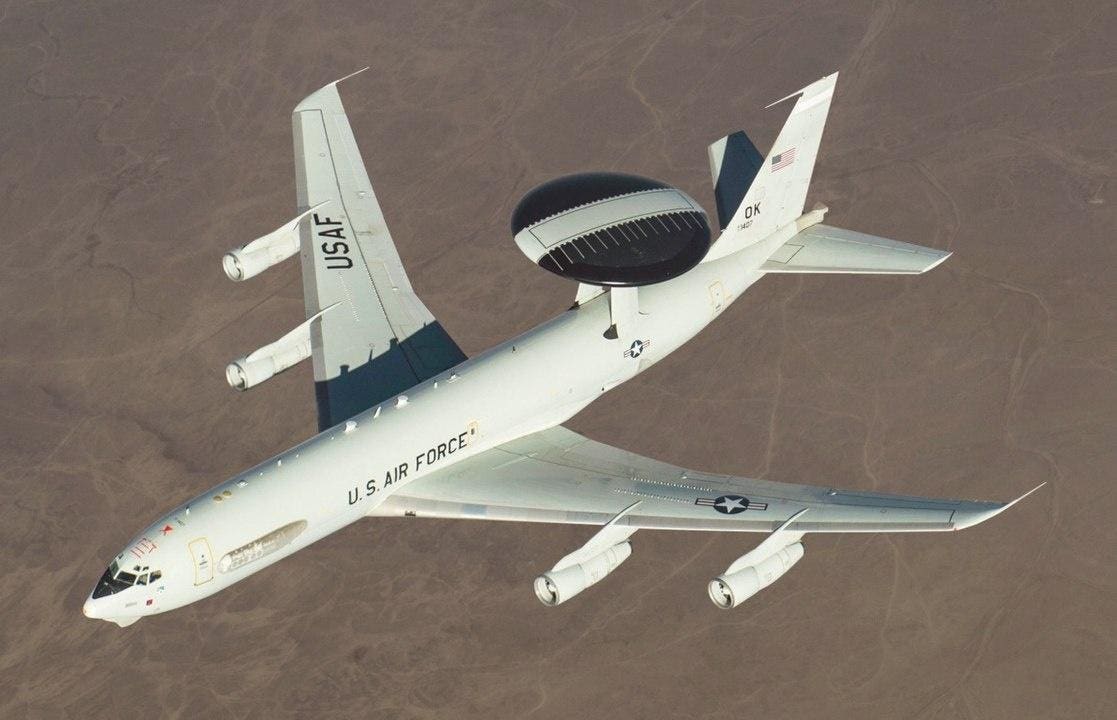The US Air Force’s fleet of E-3 airborne warning and control system (AWACS) radar planes is on its last legs. The head of Air Combat Command says the whole fleet is “in hospice care,” meaning its demise is imminent.
AWACS has played a pivotal role in monitoring airspace and managing military operations since it joined the force in 1977. But production ceased in 1992, and the Boeing
BA
The problem isn’t just that using a four-engine aircraft when more efficient twinjets are available wastes a lot of money on fuel. Finding spare parts for an airframe designed at the dawn of the jet age is increasingly difficult. Airmen must scrounge in the boneyard for items no longer in production.
But while the plane has aged out, the mission of airborne surveillance and battle management has never been more important. As the focus of US strategy shifts to the Pacific, the joint force must be able to surveil the sky over millions of square miles of ocean and adjoining land masses. That requires airborne radars with greater range and precision.
The Air Force has a solution. It is the E-7 Wedgetail, a radar plane based on the Boeing 737—the world’s most popular twinjet—that was first developed for Australia and is now operated by several allies. Boeing contributes to my think tank.
The service should have started buying Wedgetail long ago, before the mission-capable rate of the AWACS fleet collapsed. But we are where we are: last year it announced the beginning of that process, stating that the E-7 is the only available option that can be fielded in an acceptable timeframe.
The Air Force certainly is correct about the absence of suitable alternatives, but what constitutes an acceptable timeframe is open to debate. It takes four years to complete each E-7 aircraft—two years to build the aircraft at Boeing, and another two years to modify it into a radar plane—and that puts arrival of the first two E-7s in the fleet beyond the date when some observers think Beijing might make a move on Taiwan.
Hopefully, what’s left of the AWACS fleet can cover the region until E-7s arrive, but with the most decrepit planes in the current fleet already moving to the boneyard, how long the rest of the fleet can remain operational is uncertain.
Moreover, Wedgetail is intrinsically more capable than the aged AWACS planes, able to surveil larger areas and also collect electronic intelligence. This will be especially important in and around China until the Air Force’s next-generation air dominance fighter becomes available in the 2030s.
It doesn’t take much reflection to see what needs to be done. Congress should accelerate production of the E-7 to four planes per year, starting in 2024, so that there are half a dozen aircraft in the force by 2028.
It requires three planes to maintain a round-the-clock combat air patrol, so six planes are enough for two “CAPs.” There could be separate CAPs in Northeast and Southeast Asia, or alternatively one near China and one in Eastern Europe. How the planes are deployed will depend on the threat environment at the time, but the important thing is to have them available.
Some AWACS might still be usable as the decade ends, but the service is already on a glide slope from 31 to 18 airframes, and when you factor in downtime for maintenance it’s anyone’s guess how many will actually be airworthy.
Since Wedgetail is the only viable successor, it is hardly necessary to cite its virtues. However, it is worth noting that the E-7 is expected to cost only a third of what AWACS does to operate, and its mission-capable rate will be much higher.
One reason E-7 is more affordable and reliable is that it steers its radar electronically rather than mechanically. The AWACS radar physically rotates, and moving parts are subject to breakdown. Wedgetail’s phase shifting requires no moving parts, and yet delivers superior sensor performance.
Beyond that, Wedgetail is based on a commercial airframe that is widely serviced throughout the world. It is easy to find mechanics who can support the Boeing 737 in the Pacific, or in Europe, or in the Middle East. Finding someone in any of those places who can fix a Boeing 707 is a crapshoot—and that’s before we even get to the plane’s antiquated radar.
Achieving a more reasonable production rate on Wedgetail will not be a heavy lift for Congress in 2024. Although the number of planes that should be funded is twice last year’s total of two, the program only needs about 10% of each aircraft’s cost to commence production of long-lead items, namely the airframe and the radar. The rest of the cost can be funded in later years.
But Congress needs to pick up the pace to assure that the joint force’s most important aerial surveillance asset is ready if conflict threatens.
The Air Force has already identified Wedgetail as its most important unfunded priority in 2024—not because it is literally unfunded, but because it is under-funded relative to need. Imagine U.S. forces trying to defend Taiwan or Poland without an ability to accurately track and characterize hostile aircraft in nearby airspace.
AWACS can perform that task today, but only the E-7 Wedgetail can do so in the future. It needs to enter the force at a faster pace than currently planned.
E-7 integrator Boeing contributes to my think tank.
Read the full article here





